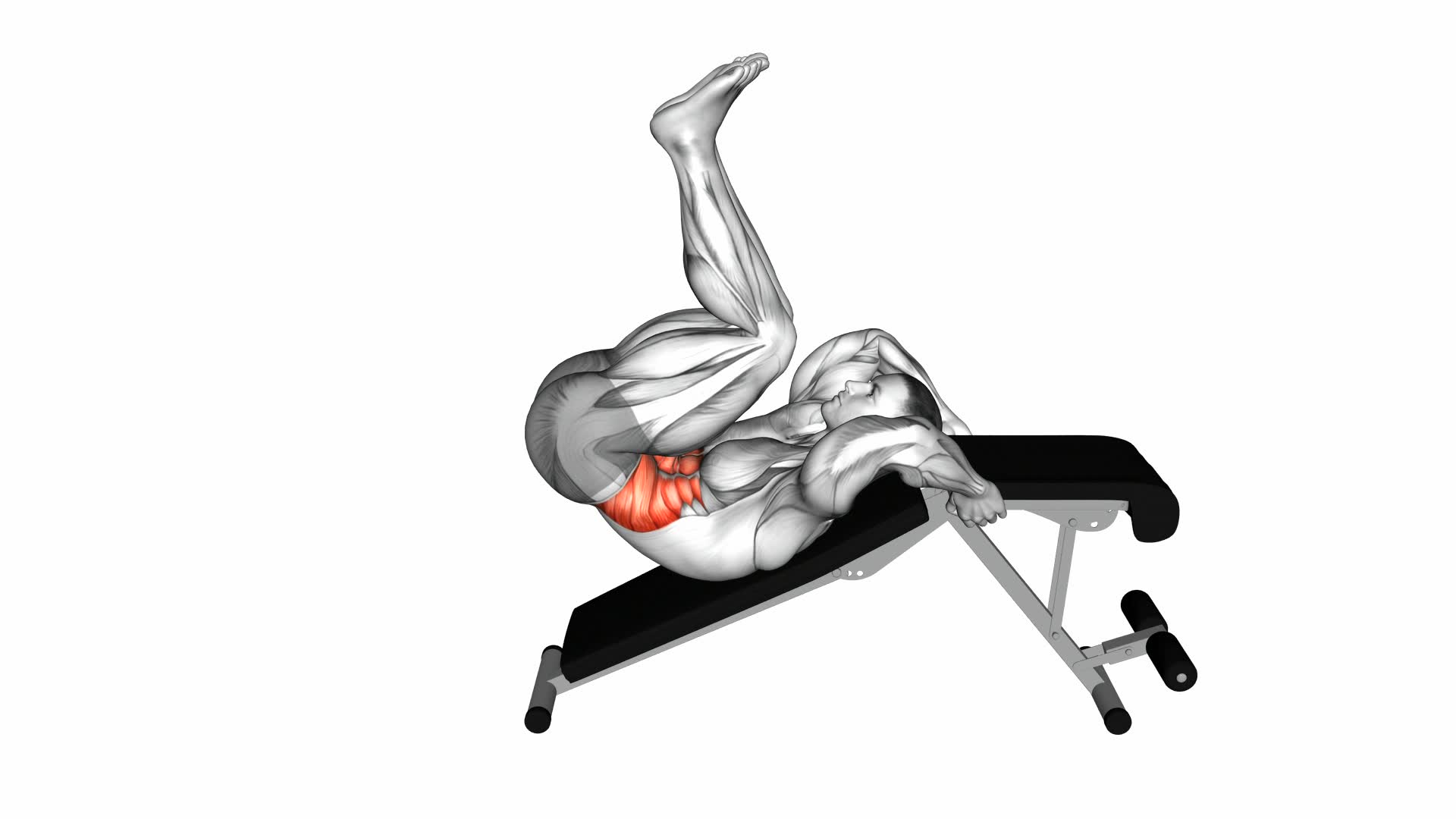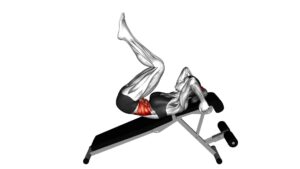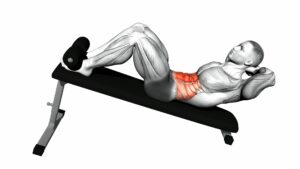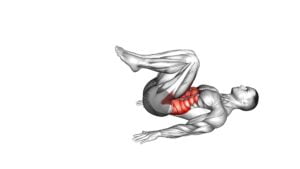Decline Bent Leg Reverse Crunch – Video Exercise Guide & Tips

Get ready to sculpt your abs with the decline bent leg reverse crunch! In this video exercise guide, you'll learn the proper form and technique to maximize your results.
Watch This Exercise Video
Avoid common mistakes and discover tips to increase intensity and difficulty. Whether you're a beginner or advanced, modifications and variations are available for all fitness levels.
Let's dive in and take your core workout to the next level!
Key Takeaways
- The decline bent leg reverse crunch strengthens abdominal muscles.
- It targets the rectus abdominis for a six-pack look.
- It activates the abs more effectively than traditional crunches.
- The exercise engages the abs to work harder with the decline angle.
Benefits of the Decline Bent Leg Reverse Crunch
One benefit of the Decline Bent Leg Reverse Crunch is that it strengthens your abdominal muscles. This exercise specifically targets your rectus abdominis, which is the muscle responsible for giving you that coveted six-pack look. By performing the decline bent leg reverse crunch, you activate your abdominal muscles more effectively compared to traditional crunches or sit-ups. The decline angle increases the resistance and engages your abs to work harder, leading to increased muscle activation and development.
To incorporate the decline bent leg reverse crunch into your ab workout routine, start by adjusting the decline bench to a comfortable angle. Lie down on the bench with your head towards the lower end and hook your feet under the footpads. Place your hands behind your head or crossed over your chest. From here, contract your abs and lift your knees towards your chest while curling your hips off the bench. Exhale as you crunch up and hold the contraction for a second before slowly lowering your legs back down.
Proper Form and Technique for the Exercise
To perform the Decline Bent Leg Reverse Crunch with proper form and technique, position yourself on the decline bench and adjust it to a comfortable angle. Lie down on the bench with your head towards the lower end, ensuring that your back is firmly pressed against the bench. Place your hands on the sides or behind your head, whichever feels more comfortable for you.
Now, bend your knees and bring them towards your chest, while keeping your feet together. This starting position will target your lower abs. Engage your core muscles by squeezing your abs and lifting your hips off the bench. At the same time, contract your abs and curl your pelvis towards your chest.
As you lift your hips, focus on using your abdominal muscles to control the movement. Avoid using momentum or swinging your legs to generate the lift. Keep the movement slow and controlled, maintaining tension in your abs throughout the exercise. Exhale as you lift your hips and inhale as you lower them back down to the starting position.
Perform the Decline Bent Leg Reverse Crunch exercise for the desired number of repetitions, aiming to improve core strength and target your lower abs. Remember to listen to your body and start with a weight and difficulty level that's suitable for your fitness level.
Common Mistakes to Avoid
Avoidance of common mistakes is crucial in performing the Decline Bent Leg Reverse Crunch exercise effectively. To ensure you get the most out of this exercise and avoid potential injuries, here are some troubleshooting tips:
- Don't use momentum: One common mistake is using momentum to swing your legs up instead of engaging your core muscles. Focus on using your abs to lift your legs and avoid any swinging or jerking motions.
- Keep your lower back pressed against the bench: Another mistake is allowing your lower back to lift off the bench during the crunch. This can strain your back and reduce the effectiveness of the exercise. Keep your lower back firmly pressed against the bench throughout the movement.
- Avoid pulling on your neck: Many people tend to pull on their neck or head during the crunch, which can strain the neck muscles. Instead, place your hands lightly behind your head for support, but avoid pulling or using them to lift your head.
- Control the movement: It's important to maintain control throughout the exercise. Avoid letting your legs drop too quickly or using momentum to swing them down. Focus on a slow and controlled movement, engaging your abs at all times.
Tips to Increase Intensity and Difficulty
To further challenge yourself and enhance the effectiveness of the Decline Bent Leg Reverse Crunch exercise, you can gradually increase the intensity and difficulty. Here are some advanced progressions for the decline bent leg reverse crunch that you can try:
- Single leg decline bent leg reverse crunch: Instead of using both legs, lift one leg at a time while performing the exercise. This engages your core muscles even more and adds an extra challenge.
- Weighted decline bent leg reverse crunch: Hold a dumbbell or a weighted plate against your chest while performing the exercise. The added resistance will increase the intensity and help you build stronger abdominal muscles.
In addition to these progressions, you can also incorporate resistance bands for an added challenge. Attach a resistance band around the base of the decline bench and loop it around your feet. As you perform the decline bent leg reverse crunch, the resistance from the band will make the exercise more difficult and engage your muscles even further.
Remember to always maintain proper form and technique while increasing the intensity. Gradually progress as your strength and stability improve to avoid injury and get the most out of your workouts.
Modifications and Variations for All Fitness Levels
For all fitness levels, there are modifications and variations available to customize the Decline Bent Leg Reverse Crunch exercise. Whether you're a beginner or an advanced fitness enthusiast, these options will allow you to tailor the exercise to your specific needs and abilities.
Here are some modifications and variations you can try:
- Equipment options for the decline bent leg reverse crunch:
- You can perform the exercise on a decline bench or use an exercise ball to increase the challenge.
- Alternatively, you can also do the exercise on a flat surface if you don't have access to any equipment.
- Alternative exercises for targeting the same muscle groups:
- If the decline bent leg reverse crunch is too challenging, you can start with the regular bent leg reverse crunch on the floor.
- To increase the difficulty, you can try the hanging leg raise, which targets the same muscles but requires more upper body strength.
- Another alternative is the lying leg raise, where you keep your legs straight and raise them up towards the ceiling.
Remember to choose modifications and variations that suit your fitness level and goals. It's always important to listen to your body and progress at a pace that feels comfortable and safe for you.
Frequently Asked Questions
How Many Calories Does the Decline Bent Leg Reverse Crunch Burn?
The decline bent leg reverse crunch is an effective exercise for targeting your abdominal muscles. It can help you burn calories and strengthen your core.
While the exact number of calories burned during this exercise can vary depending on factors such as your weight and intensity, it's generally considered to be a moderate calorie-burning exercise.
Incorporating it into your workout routine can contribute to overall calorie expenditure and aid in weight loss efforts.
Can the Decline Bent Leg Reverse Crunch Help With Reducing Belly Fat?
The decline bent leg reverse crunch is a great exercise for reducing belly fat. By engaging your abdominal muscles, this exercise helps to strengthen and tone your core area.
The benefits of the decline bent leg reverse crunch include targeting the lower abdominal muscles and improving overall core stability.
Is It Necessary to Have a Decline Bench for Performing This Exercise?
To perform the decline bent leg reverse crunch, a decline bench is typically used. However, it isn't necessary to have a decline bench for this exercise. There are alternative ways to work your abs without a decline bench, such as using an exercise ball or doing floor exercises.
While a decline bench offers added benefits like increased difficulty and targeting the lower abs, you can still achieve a good workout without one.
Can the Decline Bent Leg Reverse Crunch Be Done Without Any Equipment?
Yes, the decline bent leg reverse crunch can be done without any equipment. You can try alternative exercises like the regular bent leg reverse crunch or the hanging leg raise.
However, using a decline bench has its benefits as it allows for a greater range of motion and targets the lower abs more effectively. So, if you have access to a decline bench, it's recommended to use it for maximum results.
Are There Any Alternatives to the Decline Bent Leg Reverse Crunch That Target the Same Muscle Groups?
Looking for alternative exercises that target the same muscle groups as the decline bent leg reverse crunch? There are plenty of options to choose from!
Some alternatives include hanging leg raises, weighted Russian twists, and bicycle crunches. These exercises also engage your abs and obliques, helping to strengthen and tone your core.
Conclusion
In conclusion, the decline bent leg reverse crunch is an effective exercise for targeting the lower abs. By following proper form and technique, avoiding common mistakes, and incorporating tips to increase intensity, individuals can maximize the benefits of this exercise.
Additionally, modifications and variations make it accessible for all fitness levels. Incorporating this exercise into a regular workout routine can help improve core strength and overall fitness.

Author
Years ago, the spark of my life’s passion ignited in my mind the moment I stepped into the local gym for the first time. The inaugural bead of perspiration, the initial endeavor, the very first surge of endorphins, and a sense of pride that washed over me post-workout marked the beginning of my deep-seated interest in strength sports, fitness, and sports nutrition. This very curiosity blossomed rapidly into a profound fascination, propelling me to earn a Master’s degree in Physical Education from the Academy of Physical Education in Krakow, followed by a Sports Manager diploma from the Jagiellonian University. My journey of growth led me to gain more specialized qualifications, such as being a certified personal trainer with a focus on sports dietetics, a lifeguard, and an instructor for wellness and corrective gymnastics. Theoretical knowledge paired seamlessly with practical experience, reinforcing my belief that the transformation of individuals under my guidance was also a reflection of my personal growth. This belief holds true even today. Each day, I strive to push the boundaries and explore new realms. These realms gently elevate me to greater heights. The unique combination of passion for my field and the continuous quest for growth fuels my drive to break new ground.







